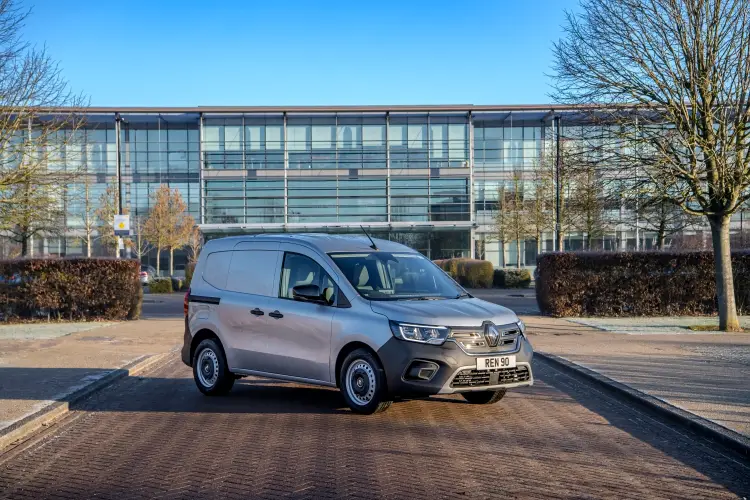By Tom Roberts - Updated 13/07/23
The light van sector has stayed pretty consistent over the last few years in terms of what’s available, with most of the newest vans on offer being launched in 2019 or before. But all of a sudden, we’re seeing a flurry of new launches including this - the all-new Renault Kangoo.
And it is all-new. Completely redesigned and brought up to date, the new Kangoo is a marked improvement on the previous generation which was beginning to feel outdated when compared to Stellantis’s light vans (Citroen Berlingo, Vauxhall Combo, etc). Its new appearance is also a huge cut above what we’ve seen from Renault’s previous light vans.
What Engines & Power Units Does The Renault Kangoo Use?
Aside from the new aesthetics, under the bonnet, the proven 95 and 115PS diesel engines are joined by a 100PS petrol engine - something of a rarity in vans. And the all-electric E-Tech Kangoo is powered by a 45kWh battery pack to provide a competitive 186 miles of range on the WLTP Combined cycle… slightly more than the Stellantis electrics.
There is truly a Kangoo for everyone now - and personally, I feel like the light van marketplace needed a vehicle like this to come along and remind us that choice AND variety means a lot to van operators.
What Sizes Is The Renault Kangoo Available In?
The Renault Kangoo range is relatively simple: there are two body lengths available called ‘ML19’ (M standing for medium despite this being the shorter of the 2), and ‘LL21’ (no prizes for guessing that the L identifies the long version, which can also be specced as a crew van).
What Trim Levels Are Available On The Renault Kangoo?
There are two trim levels to choose from, although you get some bonus features with the E-Tech.
The ‘Kangoo Start’ trim level has a decent level of equipment including automatic headlights and wipers, 3.5-inch TFT driver information display, DAB radio with Bluetooth and USB connectivity, electric front windows, manual air conditioning, cruise control, heated and electrically-adjustable door mirrors, and a height-adjustable driver’s seat. ‘E-Tech Start’ trim level adds heated seats, a heated windscreen, and automatic air conditioning.
The step up to the ‘Kangoo Advance’ trim level adds an 8-inch touchscreen display with smartphone integration via Android Auto and Apple CarPlay, an electric parking brake, reverse parking sensors, premium gear stick with chrome inserts, cloth upholstery with yellow accents, 16-inch ‘Flex’ wheels, body-coloured door rails, and a wide view mirror.
Is The Renault Kangoo’s Cabin Good?
Vans like the Ford Transit Connect and VW Caddy trade on being car-like light vans, while Stellantis vans trade on being scaled-down medium vans. The Kangoo, platform sharing as it does with the new Nissan Townstar and new Mercedes-Benz Citan, is seizing the opportunity to offer customers more choice of car-like small vans - and why not?
I felt comfy and snuggled into this cabin with its sweeping dashboard, bin-like seats and infotainment screens. Perhaps this vehicle’s biggest strength is that nothing you’d need to drive this vehicle is out of arm's reach. Ergonomics are clearly the key concern in the latest Kangoo… and I like being able to jump out of a car and into a van without feeling like I need to adapt to the new environment.
Walking you through my first experience with the cabin, I immediately noticed how high-set the gear stick is. It looked odd, but actually frees up cabin space down in the foot well and is really comfortable to use. There are also physical buttons for climate controls, which I think lots of vans are doing away with unnecessarily.
Storage is pretty generous with a wide open space in the dashboard and a pop-open storage area right above the steering wheel. You’ve got decent-sized door bins, a bit of overhead space and a little slot down below the gear lever to fill with your bits.
This van’s cabin has gone the way of other light vans in emphasising the car-like comfort and tighter driving space.
So here’s the rule… trim level makes a huge impact on which features and creature comforts you’ll enjoy in here, while body length will dictate what you get at the business end… good segway, right?
How Big Is The Renault Kangoo’s Loadspace?
You’ll get an 1.8m long load into the back of the ML19, and a useful 2.2m in the LL21, load volumes being 3.3 cubic metres and 4.2 cubic metres, respectively.
Payloads will vary depending on the engine, power unit and trim level in the vehicle you choose, but you can reckon on payloads between 802kg and 987kg for the standard fuel vans, and 615kg for the all-electric E-Tech.
These stats are exactly where they should be for a light van, and that’s the point! This is a light van for the modern age, and Renault has made sure it ticks all the right boxes in the places it counts.
Tom’s Takeaways
In my opinion, the latest Kangoo brings it perfectly into line with modern light vans. Expectations that this vehicle was going to be a revolution for the light van marketplace were unfair - this is a solid light van available at competitive pricing, and it does its job incredibly well.
I’m not being mean when I say this van does what a small van should do well, I’m complimenting it. And that there’s a version available in every flavour of fuel and electricity is the icing on the cake.


